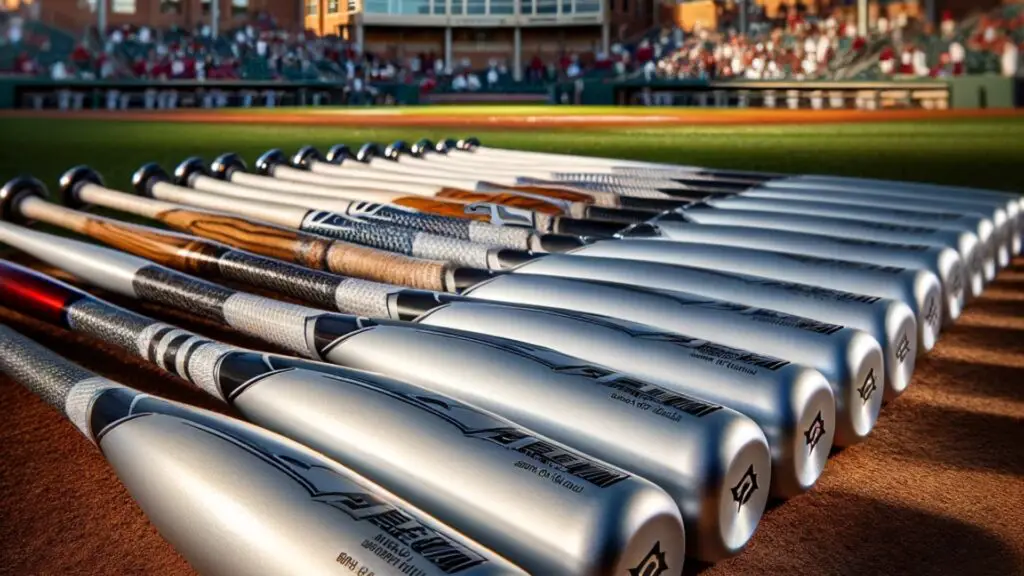
In this article:
When it comes to college baseball, one question that often arises is, “Why do they use aluminum bats?” It’s a valid query, considering the traditional association of baseball with wooden bats.
However, there are compelling reasons behind the prevalence of aluminum bats in college-level play.
First and foremost, aluminum bats are highly favored for their lightweight construction. This characteristic makes them an ideal choice for beginners, young players, and those lacking experience on the field.
Compared to their wooden counterparts, aluminum bats allow for increased swing speed, resulting in better contact with the ball and potentially higher batting averages.
Moreover, the lighter weight of aluminum bats reduces the risk of injury, as players can maneuver and swing them with greater ease.
This advantage is particularly crucial for players in their formative years, as it helps promote proper technique and prevents strain-related setbacks.
In this article, we will explore why aluminum bats have become a staple in college baseball, shedding light on the benefits they offer players at different skill levels.
Let’s delve deeper into this fascinating topic and uncover the rationale behind its prevalent usage.
Advantages of Aluminum Bats
Durable and Long-Lasting
One of the biggest advantages of aluminum bats over wooden ones is their durability and longevity. Unlike wooden bats, which can easily break or splinter during play, aluminum bats are made to withstand the rigors of regular use.
This means they do not need to be replaced as often, making them a more cost-effective option for college baseball programs. Additionally, the durability of aluminum bats means that they maintain their performance level for a longer period.
Wooden bats tend to lose their pop after a certain amount of usage, but aluminum bats remain consistent throughout their lifespan. This means that college baseball players can rely on their bats to perform well game after game.
One aspect of the game that often surprises fans is how fast a baseball comes off the bat, which can reach speeds exceeding 100 miles per hour, a testament to the skill and power of collegiate athletes.
Larger Sweet Spot
Another advantage of aluminum bats is their larger sweet spot. The sweet spot is the area on the bat where hitters can make solid contact with the ball. With a larger sweet spot, hitters have greater accuracy and power, making it easier to hit home runs and extra-base hits.
This advantage can especially benefit college players still developing their hitting skills. The larger sweet spot allows them to make contact with pitches they may have missed with a wooden bat, boosting their confidence at the plate and helping them improve as hitters overall.
Lighter Weight
Aluminum bats are also lighter in weight compared to wooden ones. This lighter weight allows batters to swing faster and with more control over the bat. The faster swing speed can translate into more power behind each hit and greater success at the plate.
In addition, since aluminum bats are lighter than wooden ones, batters do not get fatigued as quickly during long games or practices. This means they can maintain better form throughout each at-bat and avoid making mistakes due to exhaustion.
Overall, the advantages of aluminum bats make them a popular choice in college baseball. Their durability, larger sweet spot, and lighter weight all work together to give hitters an edge at the plate.
Safety Concerns with Wooden Bats
When Bats Break, They Can Be Dangerous
One of the main safety concerns with using wooden baseball bats is their increased risk of breaking or splintering during play, which can potentially cause injury to players or spectators.
When a wooden bat breaks, it can shatter into sharp pieces that fly in all directions, endangering everyone around them.
This can lead to serious injuries such as lacerations, bruises, and even broken bones. In fact, according to a study conducted by the National Center for Catastrophic Sport Injury Research (NCCSIR), between 1989 and 2006, there were 52 reported cases of fatalities related to baseball or softball activities in the United States.
Durability is Key
Aluminum bats have become popular among college baseball programs due to their increased durability and reduced likelihood of breaking compared to wooden bats.
Aluminum bats are made from a high-strength alloy engineered to withstand high-velocity impacts without cracking or splintering.
The reduced risk of breaking makes aluminum bats significantly safer than wooden bats since they don’t pose the same danger when they break.
Additionally, aluminum bats undergo rigorous testing and are subject to certification by organizations like the NCAA and USA Baseball before they’re allowed on the field.
This ensures that only safe and reliable equipment is used during games. Overall, using aluminum baseball bats has proven beneficial for reducing safety concerns related to bat breakage during play while also providing increased durability for players at all levels of competition, including college baseball programs across the country.
Cost Comparison Between Aluminum and Wooden Bats
When purchasing baseball equipment, the cost of bats can be a significant expense for college programs. In general, aluminum bats are more expensive than wooden bats.
This is because they are made with specialized materials designed to last longer and produce better performance. The average cost of an aluminum bat can range from $100-400, while wooden bats may only cost $30-100.
However, despite the higher upfront cost of aluminum bats, they can save college programs money in the long run. Wooden bats require more frequent replacement due to breaking or becoming worn out.
In contrast, aluminum bats have a longer lifespan and do not need to be replaced as often. This means that college programs can invest in fewer bats over time and allocate their limited budget towards other areas such as training facilities or travel expenses.
While discussing equipment regulations, it’s important to note that, in certain circumstances, a baseball bat can be considered a deadly weapon, which is why safety standards in college baseball are taken so seriously.
Benefits for College Programs in Terms of Budgeting and Equipment Management
In addition to saving money on equipment costs, using aluminum bats also benefits college programs regarding budgeting and equipment management.
Because aluminum bats have a longer lifespan than wooden ones, coaches and equipment managers do not need to spend as much time monitoring which players need new equipment or ordering replacements as frequently.
This also means players can focus on training without worrying about constantly replacing broken or worn-out wooden bats.
With fewer replacements needed over time, there is less pressure on coaches and players alike to think about bat maintenance or replacement costs constantly.
While the initial investment in an aluminum bat may seem steep compared to a wooden one, the long-term benefits outweigh the costs by far for many college baseball programs.
With increased durability comes less worry about replacing broken or damaged equipment for coaches and athletes – allowing everyone more time to focus solely on improving their game without distractions!
Criticisms Against Aluminum Bats
Arguments That Aluminum Bats Give an Unfair Advantage to Hitters Due to Their Increased Power Potential
One of the most significant criticisms of aluminum bats is that they give hitters an unfair advantage over pitchers.
This argument is based on aluminum bats having a larger sweet spot than wooden bats, allowing hitters to make contact with the ball more easily and generate higher exit velocities.
Additionally, aluminum bats are lighter than wooden bats and thus allow hitters to swing faster, generating even more power.
Some critics argue that this increased power potential has led to more home runs and overall offense in college baseball, making it more difficult for pitchers to compete.
In particular, some baseball purists argue that using aluminum bats changes the culture of college baseball by placing greater emphasis on hitting and reducing the importance of pitching and defense.
Discussion on How Some Leagues Have Implemented Regulations on Bat Performance to Address This Issue
In response to concerns over the performance advantages offered by aluminum bats, some leagues have implemented regulations designed to limit their power potential.
For example, in 2011, NCAA rules required all non-wooden bats used in college baseball to meet a “BBCOR” standard for performance.
The BBCOR standards require non-wooden bat manufacturers to meet specific testing requirements to limit their trampoline effect (i.e., their ability to transfer energy from the bat’s barrel into the ball upon impact).
These standards aim to reduce bat performance in such a way as not only to level out the playing field between hitters and pitchers but also to help improve player safety.
While such regulations may limit offensive production somewhat, they also help ensure player safety by reducing injury risk from balls hit at excessive speeds off batted balls.
When comparing the equipment used in different leagues, the difference between softball and baseball bats becomes apparent, not just in their physical dimensions but also in their performance and impact on the game’s dynamics.

Frequently Asked Questions
Why Are Aluminum Bats Banned From MLB?
Aluminum bats are banned from MLB and other leagues for safety concerns and to maintain a fair playing field.
Why Do MLB Players Use Wooden Bats Instead of Aluminum?
MLB players use wooden bats instead of aluminum for two primary reasons. Firstly, wooden bats provide increased safety for defending infielders, as the balls don’t travel at the same high speed or frequency as they would with metal bats. Secondly, wooden bats are more cost-effective to manufacture, making it easier to replace them when a player breaks one.
Can You Use Aluminum Bats in College Baseball?
Aluminum bats cannot be used in college baseball. NCAA regulations require college baseball players to use metal bats instead of wooden bats, particularly in NCAA tournaments. Metal bats offer increased durability and can withstand stronger swings compared to wooden bats.
Conclusion
In conclusion, the use of aluminum bats in college baseball is primarily driven by their advantages for beginners, young, and inexperienced players.
Compared to wooden bats, aluminum bats are lighter, allowing players to generate more bat speed and swing more easily.
This lighter weight makes aluminum bats more manageable and less likely to cause fatigue during long games or practices.
Additionally, aluminum bats have a larger sweet spot, providing a larger area for players to make solid contact with the ball, thus increasing the chances of hitting it with power and accuracy.
These factors contribute to the popularity of aluminum bats in college baseball, as they help players develop their skills and gain confidence at the early stages of their baseball careers.






